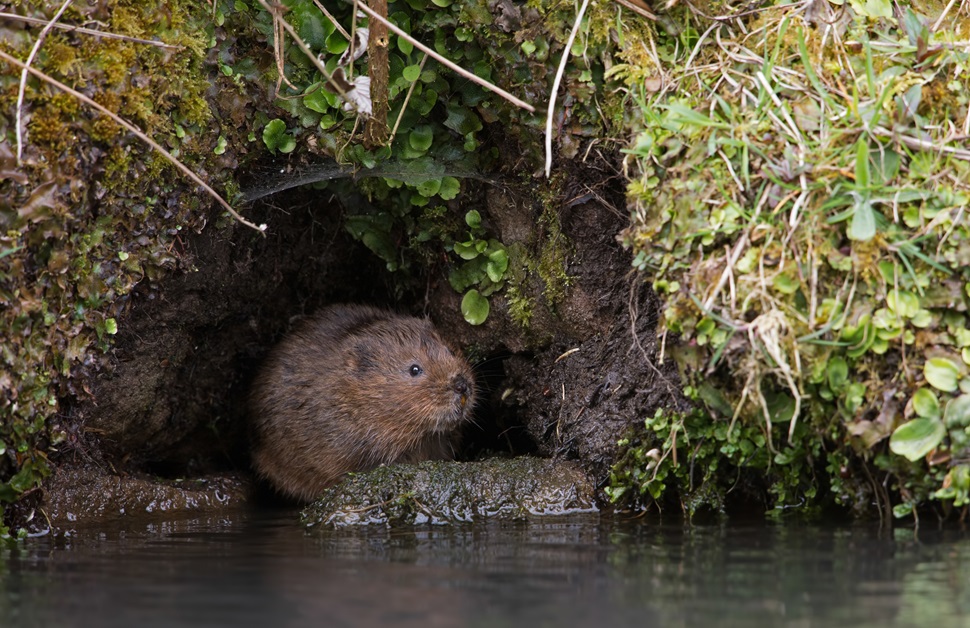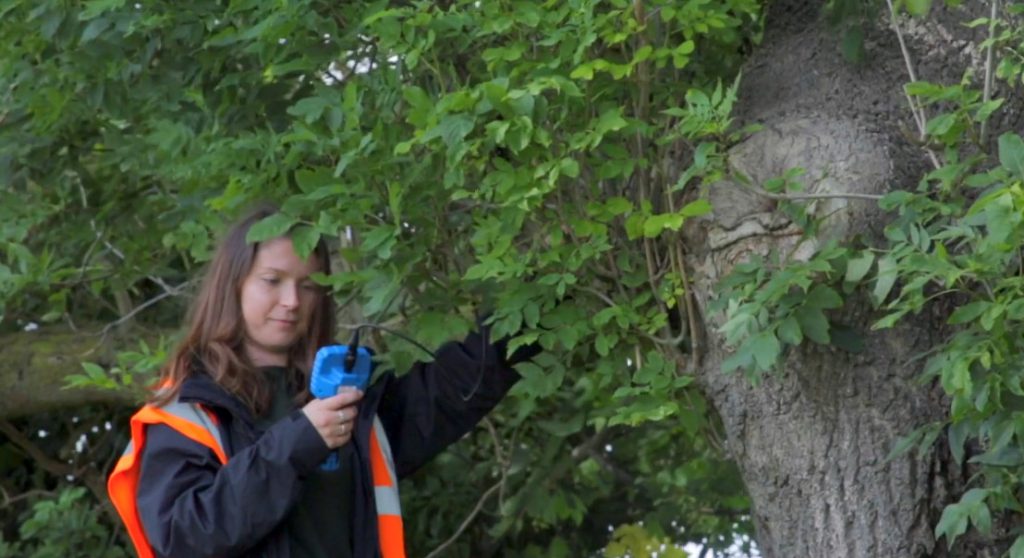Everything You Need to Know About Water Vole Surveys

A previously common species with widespread population numbers across England, Scotland and Wales, the water vole is now experiencing one of the worst declines of any mammal in the United Kingdom. In fact, the depletion of water vole populations has worsened over the past 20 years and now sees an estimated 132,000 remaining throughout Britain, leaving them entirely absent from Ireland and the majority of islands offshore from Britain aside from Anglesey and the Isle of Wight.
Best seen in the daytime, the water vole isn’t nocturnal and instead uses the day to navigate through lakes, marshes, ponds, reedbeds, rivers and streams with a water depth of less than one metre deep and a width of less than three metres wide as a means of foraging, finding new water vole burrows, and avoiding potential predators. Among the main threats to water voles are brown rats, cats, foxes, herons, marsh harriers, American mink, otters, owls, stoats and weasels, as well as golden eagles in certain parts of Scotland.
Classed within the rodent family, the water vole (Arvicola amphibius) is similar in appearance to the brown rat, but much smaller and with a blunt nose and a furry tail. It is a common misconception to label them as ‘water rats’, but this wasn’t helped by the classic children’s book The Wind in the Willows featuring a water vole called ‘Ratty’. Water vole burrows are created in the banks of waterways for sleeping and nesting, and involve various routes, entrances and exits for space and easy access.
All endangered species are listed as protected species within relevant legislation, such as the Conservation of Habitats and Species Regulations 2017 and the Wildlife and Countryside Act 1981. Due to the current situation surrounding water voles regarding their dramatic decline, it is of principal importance that they are under legal protection, preventing the deliberate killing of them, the unnecessary destruction of a water vole habitat, and any exercises or practices that could injure water voles.
In addition to the threat of predators, any activities that could harm water voles or their waterside burrows are also a possible threat to the species. As such, planning projects undertaken in an area with a water vole presence are regulated and monitored by the local authorities, preventing habitat loss and a further decrease to local populations. An ecological consultant will need to confirm an absence of water voles on the proposed development site, or if they are found close to or on the site, the necessary habitat assessments and mitigation strategies will be needed before a planning application will be considered.
Water Vole Surveys
The decision to go ahead with a water vole survey will be made based on the demands of the local planning authority, evidence found by the developer or someone else working on the development, or as a secondary measure following a prior ecology survey, such as a preliminary ecological appraisal (PEA) or ecological impact assessment (EcIA).
Either option would be appropriate for an ecological survey intended to record all protected species of animals and plants on the development site, giving the developer an overview of all ecological restrictions and making it clear what is needed next to progress. Identifying water voles on the site first-hand at this point or even simply being unable to categorically confirm that none are present will trigger the need for water vole surveys.
Water Vole Surveying
Most cases will call for a full inspection of a development site for water voles, with a focus on features and locations that are likely to house the fully protected species, such as marshes, reedbeds, rivers and streams, and the water’s edge of lakes and ponds. The ecological surveyor leading the assessment will also look for field signs of water voles, like burrow entrances, existing latrines, footprints from the fore and hind feet, and feeding signs such as neat piles of vegetation.
If the ecological consultant is able to confirm without a doubt that water voles are absent from the site, they will state that no further habitat assessments on the species are needed. Alternatively, if the ecologist has identified water voles or evidence that they are occupying the area, they will need to consider potential mitigation options. By comparing the current situation regarding the site with the proposed development plans, it will be possible to determine whether the planning project affects local populations.
A balance will be struck between efforts to encourage water vole conservation efforts and allow the development to continue as planned. Depending on the location of the present water voles, the ecology surveyor may request that certain construction activities be moved elsewhere or the plans be changed. It may be the case that even strategic land management isn’t sufficient, leading to the need for water vole mitigation measures, such as safely relocating water voles to a suitable receptor site or compensation measures involving habitat enhancements or the creation of new habitat to account for any unavoidable destruction to the natural environment.
Water Vole Survey Report
Regardless of the outcome of water vole surveys, a report from the assessment will be created. The same is true of all protected species surveys, but with each report focusing specifically on the type of wildlife in question. If an absence of water voles has been confirmed by the ecology consultant, a report will be assembled to reflect that and indicate that no additional surveys will be needed before the local planning authority can consider an application for planning permission.
Any failure to rule out water voles on the development site will prompt an ecology report containing water vole mitigation measures and compensation measures that will enable the plans to continue. If even predetermined planning or site management won’t suffice, the ecologist may call for further surveys to uncover more information. It is also likely that a mitigation or conservation licence will be needed from Natural England before water voles can be moved to such a place that is suitable away from the site.
Water Vole Survey Methodology
Across all of the protected species surveys we provide, an emphasis remains on ensuring that every assessment is undertaken with the same level of care, consideration and compliance with the rules and regulations of corresponding responsible bodies and local authorities.
You will find a high level of attention to detail and quality with the services provided by Arbtech, and the same can be said for our surveys across development sites with suspected water voles present. More information on the ways in which we monitor the standard and reliability of the water vole services we offer are detailed below.
Water Vole Survey Guidelines
Without guarantees surrounding the safeguarding of water voles, other rodents from the same family such as the bank vole and field vole, and any alternative rural communities, an inspection of water voles will be deemed invalid, as will the results and the steps intended to support development. Our ecology team maintain adherence to the competencies set by relevant organisations, such as the Mammal Society, the People’s Trust for Endangered Species (PTES) and correlating wildlife trusts.
Our assessments of water voles are guided by the parameters set by the Wildlife and Countryside Act 1981 and the Conservation of Habitats and Species Regulations 2017, as well as such best practice guidelines as WildCRU’s Water Vole Conservation Handbook (Strachan et al, 2011). Existing ties to the Chartered Institute of Ecology and Environmental Management (CIEEM), the Department for Environment, Food and Rural Affairs (DEFRA) and other regulators also dictate the validity of our water voles surveys.

Arrange Surveys for Water Voles
It is common for developers to organise a preliminary ecology assessment before breaking ground on a land or property development, as it allows them to access information on the site in a way that avoids any unexpected issues later in the process. A PRA or EcIA could then confirm the presence of a water vole, prompting a more focused inspection designed specifically for water voles.
Not only do our assessments offer the sort of protection water voles need but they also work to avoid habitat fragmentation and initiate non-native American mink control that will prevent further harm to the species. Our ecology team provide advice and execute steps forward that contribute to successful applications for planning consent and make it possible for developments to continue.
Water Vole Survey Timings
Other than the availability of our surveyors, the option to book water vole surveys is also determined based on the general behaviours of the species. All of our protected species surveys require an understanding of the ecological constraints involved, particularly when it comes to periods of hibernation or seasonal changes that occur annually.
Many listed animals hibernate during certain times of the year. Fortunately for developers working on projects with areas close to slow-flowing bodies of water, however, water voles don’t hibernate at all. Instead, they are always active but are often harder to spot during the winter months, as they are more likely to stay warm in their burrows.
Water Vole Survey Season
Optimal: April to September
Suboptimal: Not Applicable
Out of Season: October to March
Further information on the survey season of various protected species can be found on our ecology survey calendar.
Pricing of Water Vole Surveys
We do everything in our power to make our processes as fair as possible, with that naturally involving the cost of our services. Rather than placing a universal price on every survey, we start with a baseline cost and then add on any fees based on the size of the development site and the scale of the project itself.
By doing so, we stop a homeowner working on a small development site from paying the same price as a professional developer would working on a large development site. The only way of retrieving the cost for the water vole surveys on your site would be by contacting our team and providing us with your unique details.
Get Yourself a Quote Today
You can pass on your details to us by speaking directly to our administration team at Arbtech HQ in Chester. There are several ways of doing this based on your own preferences, either via social media, over the phone, by emailing us or by completing a quote form on our website. As soon as we talk you through your options, we will be able to send you a free quote for you to consider.
Placing your trust in our ecology team to lead water vole surveys on your site means remaining compliant with the Wildlife and Countryside Act 1981 and the Conservation of Habitats and Species Regulations 2017, avoiding any acts that would injure water voles, water vole habitat locations or any other fully protected species, and encouraging continued progress in your development plans.
Once the necessary water vole surveys have been completed, your report will be put together and the ecological consultant instructed to attend to your site will check that everything is in place to support your planning application. As for any remaining issues, such as concerns involving mink control, finding a suitable receptor site for relocating water voles, applications to Natural England for a mitigation licence or water vole conservation practices that will appease the relevant wildlife trusts, our team has everything covered.


